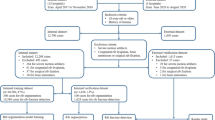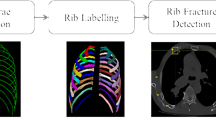Abstract
Purpose
The evaluation of all ribs on thin-slice CT images is time consuming and it can be difficult to accurately assess the location and type of rib fracture in an emergency. The aim of our study was to develop and validate a convolutional neural network (CNN) algorithm for the detection of acute rib fractures on thoracic CT images and to investigate the effect of the CNN algorithm on radiologists’ performance.
Methods
The dataset for development of a CNN consisted of 539 thoracic CT scans with 4906 acute rib fractures. A three-dimensional faster region-based CNN was trained and evaluated by using tenfold cross-validation. For an observer performance study to investigate the effect of CNN outputs on radiologists’ performance, 30 thoracic CT scans (28 scans with 90 acute rib fractures and 2 without rib fractures) which were not included in the development dataset were used. Observer performance study involved eight radiologists who evaluated CT images first without and second with CNN outputs. The diagnostic performance was assessed by using figure of merit (FOM) values obtained from the jackknife free-response receiver operating characteristic (JAFROC) analysis.
Results
When radiologists used the CNN output for detection of rib fractures, the mean FOM value significantly increased for all readers (0.759 to 0.819, P = 0.0004) and for displaced (0.925 to 0.995, P = 0.0028) and non-displaced fractures (0.678 to 0.732, P = 0.0116). At all rib levels except for the 1st and 12th ribs, the radiologists’ true-positive fraction of the detection became significantly increased by using the CNN outputs.
Conclusion
The CNN specialized for the detection of acute rib fractures on CT images can improve the radiologists’ diagnostic performance regardless of the type of fractures and reader’s experience. Further studies are needed to clarify the usefulness of the CNN for the detection of acute rib fractures on CT images in actual clinical practice.





Similar content being viewed by others
Data availability
All data support our published claims and comply with field standards.
Code availability
All software application support our published claims and comply with field standards.
Change history
15 December 2021
A Correction to this paper has been published: https://doi.org/10.1007/s10140-021-02007-z
References
Lin FC, Li RY, Tung YW, Jeng KC, Tsai SC (2016) Morbidity, mortality, associated injuries, and management of traumatic rib fractures. J Chin Med Assoc 79:329–334
Marasco SF, Martin K, Niggemeyer L, Summerhayes R, Fitzgerald M, Bailey M (2019) Impact of rib fixation on quality of life after major trauma with multiple rib fractures. Injury 50:119–124
Talbot BS, Gange CP Jr, Chaturvedi A, Klionsky N, Hobbs SK, Chaturvedi A (2017) Traumatic rib injury: patterns, imaging pitfalls, complications, and treatment. Radiographics 37:628–651
Murphy CE, Raja AS, Baumann BM, Medak AJ, Langdorf MI, Nishijima DK, Hendey GW, Mower WR, Rodriguez RM (2017) Rib fracture diagnosis in the panscan era. Ann Emerg Med 70:904–909
Dankerl P, Seuss H, Ellmann S, Cavallaro A, Uder M, Hammon M (2017) Evaluation of rib fractures on a single-in-plane image reformation of the rib cage in CT examinations. Acad Radiol 24:153–159
Cho SH, Sung YM, Kim MS (2012) Missed rib fractures on evaluation of initial chest CT for trauma patients: pattern analysis and diagnostic value of coronal multiplanar reconstruction images with multidetector row CT. Br J Radiol 85:e845–e850
Banaste N, Caurier B, Bratan F, Bergerot JF, Thomson V, Millet I (2018) Whole-body CT in patients with multiple traumas: factors leading to missed injury. Radiology 289:374–383
van Laarhoven JJEM, Hietbrink F, Ferree S, Gunning AC, Houwert RM, Verleisdonk EMM, Leenen LPH (2019) Associated thoracic injury in patients with a clavicle fracture: a retrospective analysis of 1461 polytrauma patients. Eur J Trauma Emerg Surg 45:59–63
Pinto A, Berritto D, Russo A, Riccitiello F, Caruso M, Belfiore MP, Papapietro VR, Carotti M, Pinto F, Giovagnoni A, Romano L, Grassi R (2018) Traumatic fractures in adults: missed diagnosis on plain radiographs in the emergency department. Acta Biomed 89:111–123
Liebsch C, Seiffert T, Vlcek M, Beer M, Huber-Lang M, Wilke HJ (2019) Patterns of serial rib fractures after blunt chest trauma: an analysis of 380 cases. PLoS One 14:e0224105
Hu J, Zheng ZF, Wang SH, Si DL, Yuan YQ, Gao BL (2020) Missed rib fractures on initial chest CT in trauma patients: time patterns, clinical and forensic significance. Eur Radiol 31:2332–2339
Bauman ZM, Grams B, Yanala U, Shostrom V, Waibel B, Evans CH, Cemaj S, Schlitzkus LL (2020) Rib fracture displacement worsens over time. Eur J Trauma Emerg Surg. https://doi.org/10.1007/s00068-020-01353-w
Chien CY, Chen YH, Han ST, Blaney GN, Huang TS, Chen KF (2017) The number of displaced rib fractures is more predictive for complications in chest trauma patients. Scand J Trauma Resusc Emerg Med 25:19
Simon BJ, Chu Q, Emhoff TA, Fiallo VM, Lee KF (1998) Delayed hemothorax after blunt thoracic trauma: an uncommon entity with significant morbidity. J Trauma 45:673–676
LeCun Y, Bengio Y, Hinton G (2015) Deep learning. Nature 521:436–444
Yasaka K, Akai H, Abe O, Kiryu S (2018) Deep learning with convolutional neural network for differentiation of liver masses at dynamic contrast-enhanced CT: a preliminary study. Radiology 286:887–896
Nam JG, Park S, Hwang EJ, Lee JH, Jin KN, Lim KY, Vu TH, Sohn JH, Hwang S, Goo JM, Park CM (2019) Development and validation of deep learning-based automatic detection algorithm for malignant pulmonary nodules on chest radiographs. Radiology 290:218–228
Ueda D, Yamamoto A, Nishimori M, Shimono T, Doishita S, Shimazaki A, Katayama Y, Fukumoto S, Choppin A, Shimahara Y, Miki Y (2019) Deep learning for MR angiography: automated detection of cerebral aneurysms. Radiology 29:187–194
Zhou QQ, Wang J, Tang W, Hu ZC, Xia ZY, Li XS, Zhang R, Yin X, Zhang B, Zhang H (2020) Automatic detection and classification of rib fractures on thoracic CT using convolutional neural network: accuracy and feasibility. Korean J Radiol 21(7):869–879
Zhou QQ, Tang W, Wang J, Hu ZC, Xia ZY, Zhang R, Fan X, Yong W, Yin X, Zhang B, Zhang H (2021) Automatic detection and classification of rib fractures based on patients’ CT images and clinical information via convolutional neural network. Eur Radiol 31:3815–3825
Meng XH, Wu DJ, Wang Z, Ma XL, Dong XM, Liu AE, Chen L (2021) A fully automated rib fracture detection system on chest CT images and its impact on radiologist performance. Skeletal Radiol 50:1821–1828
Weikert T, Noordtzij LA, Bremerich J, Stieltjes B, Parmar V, Cyriac J, Sommer G, Sauter AW (2020) Assessment of a deep learning algorithm for the detection of rib fractures on whole-body trauma computed tomography. Korean J Radiol 21:891–899
Zura R, Xu ZJ, Della Rocca GJ, Mehta S, Steen RG (2017) When is a fracture not “fresh”? Aligning reimbursement with patient outcome after treatment with low-intensity pulsed ultrasound. J Orthop Trauma 31:248–251
Bemelman M, Baal MV, Raaijmakers C, Lansink K, Leenen L, Long W (2019) An interobserver agreement study with a new classification for rib fractures. Chirurgia (Bucur) 114:352–358
Zhang B, Jia C, Wu R, Lv B, Li B, Li F, Du G, Sun Z, Li X (2021) Improving rib fracture detection accuracy and reading efficiency with deep learning-based detection software: a clinical evaluation. Br J Radiol 94:20200870
Ren S, He K, Girshick R, Sun J (2017) Faster R-CNN: towards real-time object detection with region proposal networks. IEEE Trans Pattern Anal Mach Intell 39:1137–1149
Hirai T, Korogi Y, Arimura H, Katsuragawa S, Kitajima M, Yamura M, Yamashita Y, Doi K (2005) Intracranial aneurysms at MR angiography: effect of computer-aided diagnosis on radiologists’ detection performance. Radiology 237:605–10
Chakraborty DP, Berbaum KS (2004) Observer studies involving detection and localization: modeling, analysis, and validation. Med Phys 31(8):2313–2330
Jin L, Yang J, Kuang K, Ni B, Gao Y, Sun Y, Gao P, Ma W, Tan M, Kang H, Chen J, Li M (2020) Deep-learning-assisted detection and segmentation of rib fractures from CT scans: development and validation of Frac Net E Bio Medicine 62:103106
Kaiume M, Suzuki S, Yasaka K, Sugawara H, Shen Y, Katada Y, Ishikawa T, Fukui R, Abe O (2021) Rib fracture detection in computed tomography images using deep convolutional neural networks. Medicine 100:e26024
Funding
This study was funded by the FUJIFILM Corporation.
Author information
Authors and Affiliations
Contributions
MA: conceptualization, methodology, investigation, writing—original draft.
HN: methodology, investigation.
MT: methodology, formal analysis, investigation, writing—original draft.
KN: methodology, formal analysis, investigation, writing—original draft.
SK: formal analysis, investigation, writing—original draft.
NS: investigation.
TT: investigation.
RM: investigation.
YH: investigation.
TI: investigation.
AK: investigation.
MS: investigation.
MK: investigation.
KM: investigation.
TM: investigation.
HO: investigation.
TH: conceptualization, methodology, writing—review and editing.
Corresponding author
Ethics declarations
Ethics approval
This study was performed in line with the principles of the Declaration of Helsinki. Approval was granted by the Ethics Committee of University of Miyazaki Hospital. Informed patient consent was waived.
Consent to participate
This retrospective study was reviewed and approved by our institutional review board. Informed patient consent was waived.
Consent for publication
All authors of this submission approved the version to be published. All authors have understood the journal’s licensing policy.
Conflict of interest
Mizuki Takei and Keigo Nakamura are employees of the FUJIFILM Corporation. The other authors declare that they have no conflict of interest in regard to this study.
Additional information
Publisher’s note
Springer Nature remains neutral with regard to jurisdictional claims in published maps and institutional affiliations.
The original online version of this article was revised: Originally, the article was published with inverted name of the Author Aya Kimura, incorrect Figure 3 caption and incomplete references 11 to 12. We have now corrected the errors accordingly.
Rights and permissions
About this article
Cite this article
Azuma, M., Nakada, H., Takei, M. et al. Detection of acute rib fractures on CT images with convolutional neural networks: effect of location and type of fracture and reader’s experience. Emerg Radiol 29, 317–328 (2022). https://doi.org/10.1007/s10140-021-02000-6
Received:
Accepted:
Published:
Issue Date:
DOI: https://doi.org/10.1007/s10140-021-02000-6




